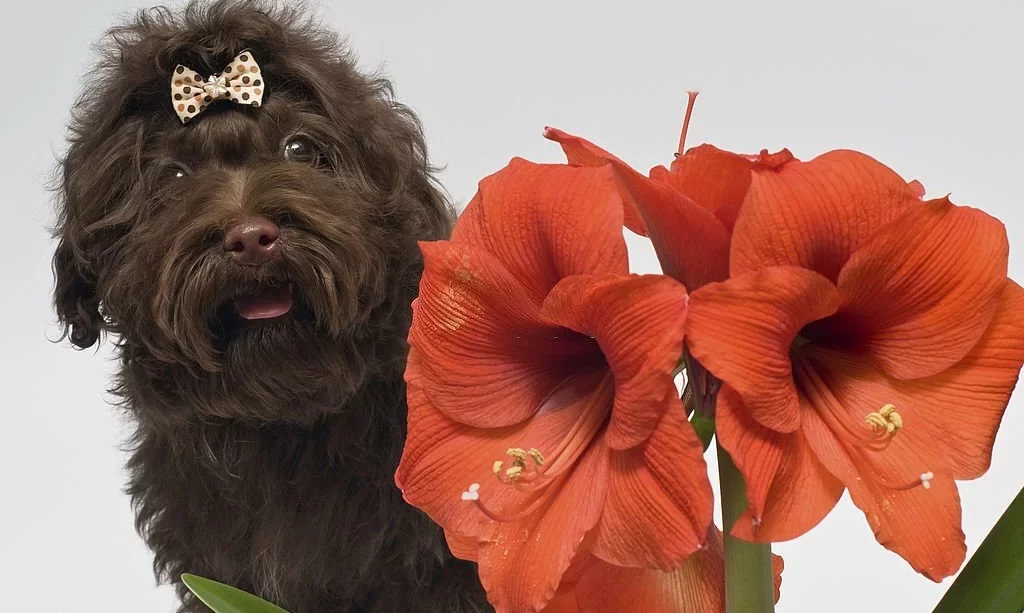Our dogs are not just pets; they’re beloved members of our families. As responsible pet owners, it’s vital that we provide them with a safe and nurturing environment. This includes being aware of potential hazards in our homes and gardens, especially when it comes to plants. In this article, we will delve into the safety of amaryllis plants in the context of our canine companions. Amaryllis, with its striking and vibrant blooms, is a popular choice for adding elegance to our living spaces and gardens. However, before we explore whether amaryllis is safe for dogs, let’s first understand what amaryllis plants are and the diverse range of species and varieties they encompass.
- No water or planting needed
- Guaranteed to bloom
- Multiple Amaryllis Blooms in 4-8 Weeks
- Chilled until shipped for bulb health
- Gift ready packing for the ideal presentation
What Are Amaryllis Plants?
Amaryllis, scientifically known as Hippeastrum, is a group of flowering bulbous plants known for their eye-catching and often fragrant flowers. These plants are celebrated for their ornamental value and are frequently used in floral arrangements and indoor decorations. The name “amaryllis” is often used to refer to common houseplants with large, trumpet-shaped flowers that come in a wide array of colors.
Amaryllis plants include various species and hybrids, each with its unique characteristics and bloom patterns. Some popular varieties include the classic red amaryllis, as well as those with white, pink, or striped petals. These plants are favored for their ability to brighten up our homes during the winter months.
However, as dog owners, it’s essential to explore whether these beautiful blooms harbor any potential dangers for our four-legged friends. Let’s dive deeper into this topic to ensure the safety and well-being of our dogs.
Potential Dangers of Amaryllis to Dogs
While amaryllis plants are prized for their aesthetic appeal, they can potentially pose risks to our canine companions. The primary concern lies in the substances contained within these plants. Amaryllis plants contain alkaloids, particularly lycorine, which can be toxic to dogs when ingested. These toxic compounds are found not only in the bulbs but also in the leaves and flowers of the plant.
Common Symptoms of Amaryllis Poisoning in Dogs
Recognizing the signs of amaryllis poisoning in dogs is crucial for prompt intervention and treatment. The symptoms can vary in severity but often include:
- Gastrointestinal Distress: Dogs may exhibit vomiting, diarrhea, and abdominal pain shortly after ingesting any part of the amaryllis plant.
- Drooling: Excessive salivation or drooling can be an early sign of plant toxicity.
- Lethargy: Affected dogs may appear unusually tired and weak.
- Loss of Appetite: A sudden loss of interest in food can be an indication of poisoning.
- Oral Irritation: Dogs may paw at their mouths or show signs of discomfort in the oral cavity.
In severe cases, amaryllis poisoning can lead to more serious health complications. Therefore, if you suspect that your dog has ingested any part of an amaryllis plant and exhibits these symptoms, it’s crucial to seek immediate veterinary care.
Preventing Amaryllis Poisoning
Prevention is the key to keeping your canine companion safe from amaryllis poisoning. Here are some practical steps for dog owners to take:
- Plant Placement: Keep amaryllis plants out of reach by placing them in areas inaccessible to your dog, both indoors and in your garden.
- Supervision: Supervise your dog when they are in areas where amaryllis plants are present, especially if your dog has a tendency to chew on plants.
- Education: Ensure that family members and anyone who cares for your dog is aware of the dangers of amaryllis plants and the importance of keeping them away from dogs.
- Safe Alternatives: Consider dog-friendly plants and flowers for your garden and home. There are many non-toxic options that can provide beauty without posing risks to your dog.
By following these precautions and being aware of potential risks, you can create a safe environment for your dog and enjoy the beauty of amaryllis plants without worrying about potential poisoning hazards.
What to Do If Your Dog Is Exposed
If you suspect that your dog has been exposed to amaryllis plants and is displaying symptoms of poisoning, taking immediate action is essential:
- Remove the Plant: Safely remove any remaining amaryllis plant from your dog’s vicinity to prevent further ingestion.
- Contact a Veterinarian: Call your veterinarian or an emergency pet clinic right away. Describe the symptoms and follow their guidance.
- Collect Samples: If possible, collect samples of the plant or any material your dog may have vomited or chewed. This can help the veterinarian assess the situation more effectively.
- Provide Comfort: While waiting for professional assistance, keep your dog calm, comfortable, and away from any remaining amaryllis plant material.
Remember that early intervention is crucial in cases of plant poisoning, so do not delay seeking veterinary care.
Safe Alternatives for Dog-Friendly Gardens
Creating a dog-friendly garden allows you to enjoy a beautiful outdoor space without putting your canine companion at risk. Consider these alternatives to amaryllis:
- Dog-Safe Plants: Choose plants that are known to be non-toxic to dogs, such as marigolds, sunflowers, or roses.
- Herb Garden: Grow a herb garden that includes safe herbs like rosemary, basil, or mint. These can add fragrance and utility to your garden.
- Dog-Friendly Ground Cover: Opt for ground covers like creeping thyme or clover that are safe for dogs to walk on and explore.
- Fencing: Install secure fencing to create boundaries and keep your dog away from potentially harmful plants.
By selecting these dog-friendly options, you can create an environment where both you and your canine companion can enjoy the outdoors safely.
- STARTER HERBS: This four pack of Rosemary is a great start to your own rosemary field or in addition to your current garden!
- GROWTH: Rosemary can get up to 6ft tall and 4ft wide. The shrub has a moderate growth rate. It will reach its mature size and begin flowering in its second season.
- CARE: Rosemary prefers full sun, meaning at least six hours of direct sunlight on most days. Rosemary shrubs have good drought tolerance once they are mature, Allow the top few inches of soil to dry out between waterings.
- FUN FACT: Rosemary is a rich source of antioxidants and anti-inflammatory compounds, which are thought to help boost the immune system and improve blood circulation.
- LIVE PLANTS: Our plants are grown exclusively for Deep Roots and The Three Company, shipped fresh directly from our greenhouse to you!
Conclusion
Our dogs bring joy and companionship to our lives, and it’s our responsibility to ensure their safety in our homes and gardens. Amaryllis plants, with their captivating beauty, can potentially pose risks to dogs due to the toxic substances they contain. Recognizing the signs of amaryllis poisoning and taking swift action is vital for your dog’s health.
To prevent amaryllis poisoning, choose dog-friendly plants and follow safety precautions, ensuring that your dog can explore and enjoy your garden without encountering toxic plants. By taking these measures and staying informed about potential risks, you can create a safe and enjoyable environment for your dog, allowing both you and your furry friend to relish the wonders of nature without worry.





